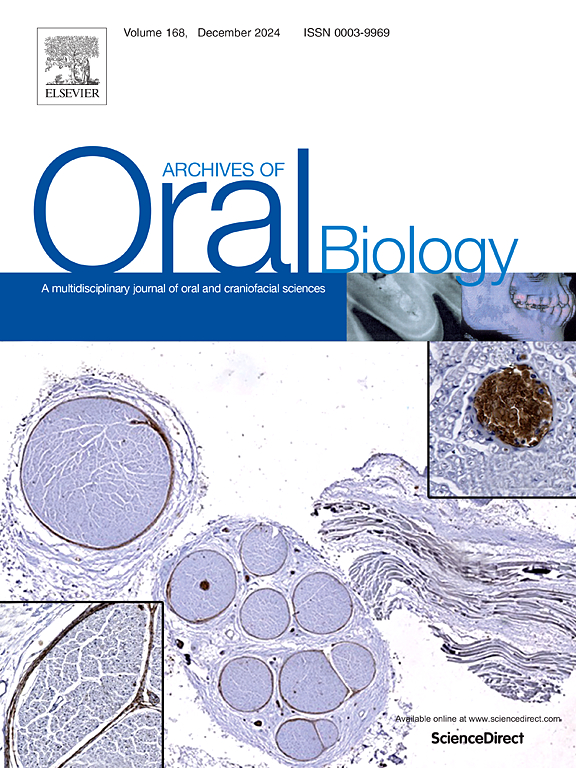Effects of mechanical load on mandibular condylar cartilage and subchondral bone of male rats
IF 2.1
4区 医学
Q2 DENTISTRY, ORAL SURGERY & MEDICINE
引用次数: 0
Abstract
Objective
The mandibular condylar cartilage plays significant roles in growth and articular function. This study evaluated the influence of increased joint loading on the growth of the condylar cartilage and the morphology of the mandible.
Design
Forty 7-week-old male Wistar rats were assigned to two groups: a control group and an incisal bite plane group. The condylar cartilage and subchondral bone were evaluated via histochemistry, bone histomorphometry with microcomputed tomography (micro-CT), and real-time polymerase chain reaction (PCR) at 2 and 4 weeks. The morphology of the mandible was analyzed via micro-CT.
Results
The chondrocytic cell layer became thinner in the posterosuperior region after 2 and 4 weeks of wearing the bite plane. Hypertrophied chondrocytes and calcified cartilage matrix disappeared. Subchondral bone, which runs parallel to the lower border of the chondrocytic cell layer, increased. Bone volume fraction (BV/TV), trabecular thickness (Tb.Th), and trabecular number (Tb.N) increased, while the amount of endochondral bone formation decreased, in the posterosuperior region of the condyle in the bite plane group, which also had reduced mRNA levels of type II collagen, type X collagen, and tartrate-resistant acid phosphatase but increased levels of osteocalcin and alkaline phosphatase. The total mandibular length and ramus height were significantly shorter in the bite plane group, although there was no significant group difference in the length of the mandibular body.
Conclusions
The biomechanical environment regulates the cellular organization of the condylar cartilage and bone formation in its subchondral region, which may eventually change mandibular morphology.
机械载荷对雄性大鼠下颌髁突软骨和软骨下骨的影响
目的下颌髁突软骨在生长发育和关节功能中起重要作用。本研究评估了关节负荷增加对髁突软骨生长和下颌骨形态的影响。设计将40只7周龄雄性Wistar大鼠分为两组:对照组和切牙平面组。在第2周和第4周通过组织化学、显微计算机断层扫描(micro-CT)骨组织形态测量和实时聚合酶链反应(PCR)评估髁突软骨和软骨下骨。通过显微ct分析下颌骨的形态。结果佩戴2周和4周后,后上区软骨细胞层变薄。肥大软骨细胞和钙化软骨基质消失。平行于软骨细胞层下边界的软骨下骨增加。咬平面组髁突后上区骨体积分数(BV/TV)、骨小梁厚度(Tb.Th)、骨小梁数目(Tb.N)增加,软骨内成骨量减少,II型胶原、X型胶原和抗酒石酸酸性磷酸酶mRNA水平降低,骨钙素和碱性磷酸酶水平升高。咬合平面组下颌骨总长度和支高均明显短于平面组,但下颌骨体长度组间差异无统计学意义。结论生物力学环境调节髁突软骨的细胞组织及其软骨下区骨形成,并最终改变下颌形态。
本文章由计算机程序翻译,如有差异,请以英文原文为准。
求助全文
约1分钟内获得全文
求助全文
来源期刊

Archives of oral biology
医学-牙科与口腔外科
CiteScore
5.10
自引率
3.30%
发文量
177
审稿时长
26 days
期刊介绍:
Archives of Oral Biology is an international journal which aims to publish papers of the highest scientific quality in the oral and craniofacial sciences. The journal is particularly interested in research which advances knowledge in the mechanisms of craniofacial development and disease, including:
Cell and molecular biology
Molecular genetics
Immunology
Pathogenesis
Cellular microbiology
Embryology
Syndromology
Forensic dentistry
 求助内容:
求助内容: 应助结果提醒方式:
应助结果提醒方式:


